|
Roden
Kit Number 046
An-12 BK-PPS
(Cub C) |
|
Reviewed By Jim Pearsall, #2209 |
|
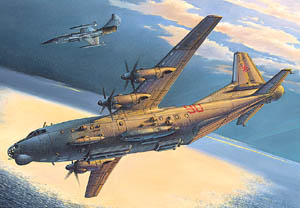 |
|
MSRP: $44.98 USD The An-12BK PPS was an aircraft with a
different mission. ECM is not much talked about, and the glamour just
isn’t there. Until the opponent’s air defense makes life miserable for
the fighters and bombers. The Cub-C and D carried a large jamming
transmitter, designed to blanket search radars on the other side of the
front and degrade AAA and SAM targeting radar systems. The An-12BK PPS
carries a number of external antennas, plus some interesting vents and
scoops, probably for power units and cooling.
The basic airframe is the An-12 Cub, analogous to the C-130 in size and
mission. 4 turboprops, high wing, short/unpaved field capable, with a fair
cargo capacity. Unlike the C-130, the An-12 is no longer in production,
having been replaced by newer and more capable aircraft types.
I did find a mention of the Cub-C/D in World Airpower Journal Volume
27, Winter 1996. It has (black & white) photos of operational Cub Cs & Ds
and line drawings. The magazine disagrees with Roden on the NATO
designation of the An-12 BK PPS aircraft, calling it Cub-D. According to
WAJ, the Cub-D carried the huge (15 foot / 5 meter) “Sirena” jamming pods
on both sides of the forward fuselage and vertical stabilizer. The
An-12PP, which WAJ calls “Cub-C” did not carry these pods, which would be
the big visual difference between the Cub C and Cub D. Nevertheless, this
is definitely a model of an operational aircraft type. |
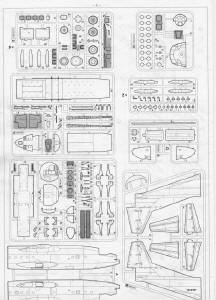 |
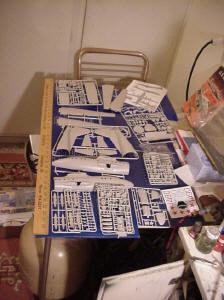 |
|
The Model I was prepared for a large box, and
large sprues, having recently built a 1/72 C-130, and was not
disappointed. I find the engineering thought which went into the design
of the trees to be pretty inventive. There are 4 engines, so each engine
assembly is on a single sprue, 4 identical sprues packed in the kit.
These also include half a nose wheel (4 halves = 2 wheels), plus 1 main
gear wheel (4 main wheels). If they use 4 identical molds to make these
sprues, or use the same one 4 times will make a difference on how good
this kit will be in 10 years. If they use this mold 4 times as much as
the others, it will wear out. If they have 4 (or more) of this mold, it
will hold up as well as the fuselage, wings, etc.
Since the ECM pods and antennas are in sets of 2, there are 2 sprues
for them. |
|
 |
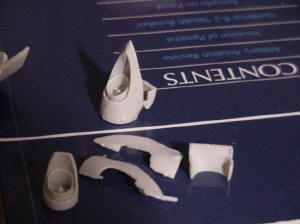 |
|
Assembly
The instructions start out with multi-lingual cautions
and a paint chart which gives color references for Humbrol, Model Master,
Gunze Sanyo and Lifecolor paints.
From there, it’s the standard pictorial instructions,
with part numbers and sprue references making it fairly easy to locate and
assemble parts. I followed the assembly sequence, and found another
little engineering trick. Since I was spending time on step 8, the
cockpit, the engine front assemblies from step 7 were getting a chance to
rest before assembling the engine back assemblies in step 9. Then
assembling the props (4 blades and 2 spinner parts per prop), the scoops,
the horizontal stabs and the fuselage allowed the engine rear assemblies
to get solid before mating them to the front in step 20.
It was the engine assemblies which convinced me this is
a kit for experienced modelers. I figured out how to use the cowl front
to insure I got the engine front section round, but had more
trouble getting the rear sections to mate securely and still have the
correct circular cross section. No locating pins, not much support, and
flat surfaces meeting which had to be held until everything set up. I
used some putty on the back sections, mostly because I wasn’t able to keep
everything together perfectly. My problem, not Roden’s.
I also had to spend some time getting the mating
surfaces of the front and rear engine sections to meet cleanly. They
didn’t assemble with perfectly flat surfaces, so I squared them up by
rubbing on a sheet of sandpaper on a table. Then I had to be careful
to get the sections to line up radially. There are seam lines on the
bottom of the cowl, which give the alignment, but I would have really
appreciated something with a split ring on one section and a tab on the
other. But how many times have you had to narrow the tab because it
doesn’t line up? Again, patience will have to carry this one through.
I didn’t spruce up the interior beyond painting the
seats and putting the instrument panel decal on. |
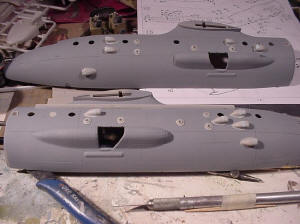 |
 |
|
The fuselage exterior is quite interesting. I painted
the fuselage first because I knew I’d have to add the windows from the
inside, and didn’t want to mask the clear parts.
This is the step where you add all the scoops, exhaust
ports and antennas to the front section of the fuselage. Because the kit
is a modified Cub, there are no locating marks, etc. The measurements
given on the instruction sheet need to be carefully looked at. I finally
had to copy the drawing at 200% so I could really comprehend it.
After adding all the built-in drag, I inserted the
interior. It fits nicely, and I had no problem getting everything to line
up with the fuselage. I particularly liked the wheel wells built into the
floor board, with alignment tabs to get everything to match. I appreciate
good engineering practice! |
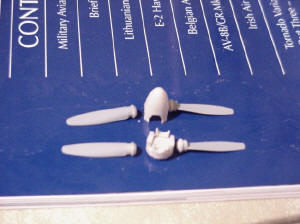 |
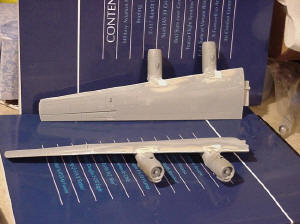 |
|
The props are each 6 pieces, so it’s a little finicky
to get the blades all aligned. I pre-painted the prop blades before
assembly, as the section of the blade inside the hub is silver, with the
inner third of the leading edge of each blade also silver. After
assembly, I painted the front of each hub black, and added the yellow
warning tips on each blade.
The fuselage continued. I assembled the tail section,
then mated it to the front of the fuselage. I left off the ECM pods
because I know I would have broken the fairly light mounting brackets at
least twice during the fiddling and filling required to get the tail to
mate.
The wing assemblies were well thought out. Each engine
fits in its particular place on the leading edge. The wings have sweep as
well as taper, so each engine fits slightly differently, and the left side
and right side obviously are not interchangeable. I left the props off
the wings, to wait until I had done all the manhandling necessary to get
the wing root joints clean and smooth. |
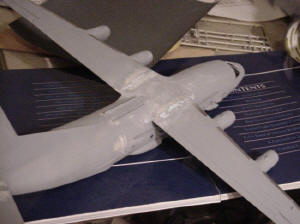 |
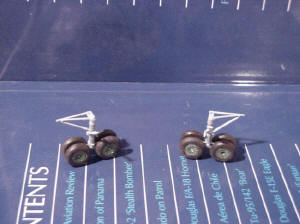 |
|
The wings fit tightly against the fuselage, and the
locating tabs are large and fit the holes in the wing root tightly. It’s
a good thing that the locators actually put the wing in correct alignment
and position. Be a shame to waste good engineering.
I added weight to the fuselage here. Roden suggests
putting a 100 gram weight in the forward radome, just under the navigator
position. Not sure what element they’re suggesting using, but 100 gm of
lead won’t fit inside that radome. I wound up punching out one of the
windows and filling the compartment behind the cockpit with shot and white
glue to get the nose to sit down.
I put on the decals before adding the landing gear, the
nose and cockpit glazing, and the antennas, pods, etc. The large decals
were a handful, as the decal film is thin, and tore if I tried to move it
too much. I had some difficulty figuring out where all the small decals
went. There’s an enlarged drawing showing where they go, but no point of
reference between the enlargement and the standard drawing. You’re left
to figure out what part of the fuselage you’re looking at in the enlarged
illustration.
The landing gear is astonishingly robust, considering
that the actual aircraft uses multiple struts. When reduced to 1/72,
these become too spindly for any one to really be strong enough. But the
design proves itself, and after all the struts are assembled, the gear
supports the model with no rock, shake or twist.
When I assembled the canopy and nose glazing, I found a
big step between the canopy and the fuselage top. File, putty, sand, and
repaint. I ran out of dark grey during this step, and had to buy another
bottle.
Finishing touches. I added the props and the ECM
pods. Finished!!! A final coat of Future, and it’s ready to go to
the next Craig Hewitt Chapter meeting. |
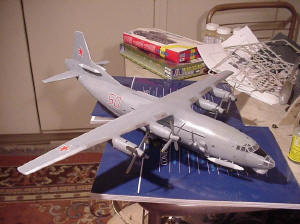 |
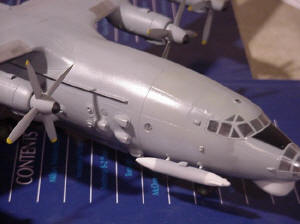 |
|
A look back… This was a large project for me, very
ambitious. It would take lots of patience, outstanding craftsmanship, and
a good deal of time to produce an An-12 which would place in an IPMS
Regional. If I were going to do another of these, I would spend some time
making templates from card stock to allow exact placement and alignment of
the add on parts. I would spend less time worrying about panel lines.
The finished model is a real attention getter, even with the single color
paint scheme. This is probably the only kit you’ll ever see of this
particular aircraft type. If you’re interested in Soviet aircraft, or you
have any interest in AEW, this kit is a “must have”. |
|
Information, images, and all
other items placed electronically on this site are the intellectual
property of IPMS/USA ®. |
| |